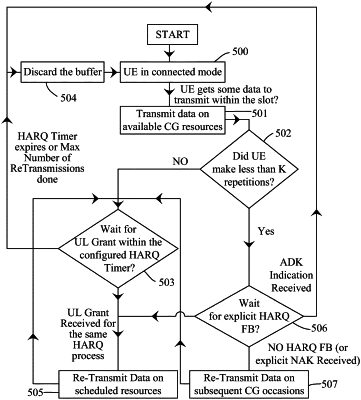| CPC H04L 1/1812 (2013.01) [H04L 5/0055 (2013.01); H04W 72/23 (2023.01)] | 20 Claims |

|
1. A method for uplink transmission on configured grant resources in a cellular wireless communications network, comprising:
at a base station, allocating recurring uplink transmission resources to a user equipment (UE), wherein the allocated recurring uplink transmission resources are grouped with N occasions in each of a repeating period P, and defining a number of repetitions K to be used for uplink transmission of transport blocks using the recurring uplink transmission resources;
transmitting an indication of the allocated recurring uplink transmission resources, including the number of repetitions K, and the N occasions to the UE;
at the UE, transmitting repetitions of a transport block within a single one of the periods P, each repetition being transmitted on an occasion of the N occasions in the period P;
at the UE, 4 when the number of transmitted repetitions is less than K, applying an explicit Hybrid Automatic Repeat Request (HARQ) feedback process, and when the number of successfully transmitted repetitions is K, applying a HARQ timer-based HARQ process, in which the UE waits for a HARQ period, and when the HARQ timer expires without receiving an UL Grant message, the UE does not retransmit the transport block, and when an indication of a failed reception is received, the UE retransmits the transport block on the indicated resources; and
at the base station:
when the number of received repetitions is less than K, and the transport block is successfully decoded, transmitting a positive HARQ acknowledgment;
when the number of received repetitions is less than K, the transport block is not successfully decoded, and the UE can be identified, transmitting a negative HARQ indication; and
when the number of received repetitions is K, and the transport block is successfully decoded, not transmitting a positive HARQ acknowledgement; and
when the number of received repetitions is K, and the transport block is not successfully decoded, transmitting an UL grant for re-transmission.
|